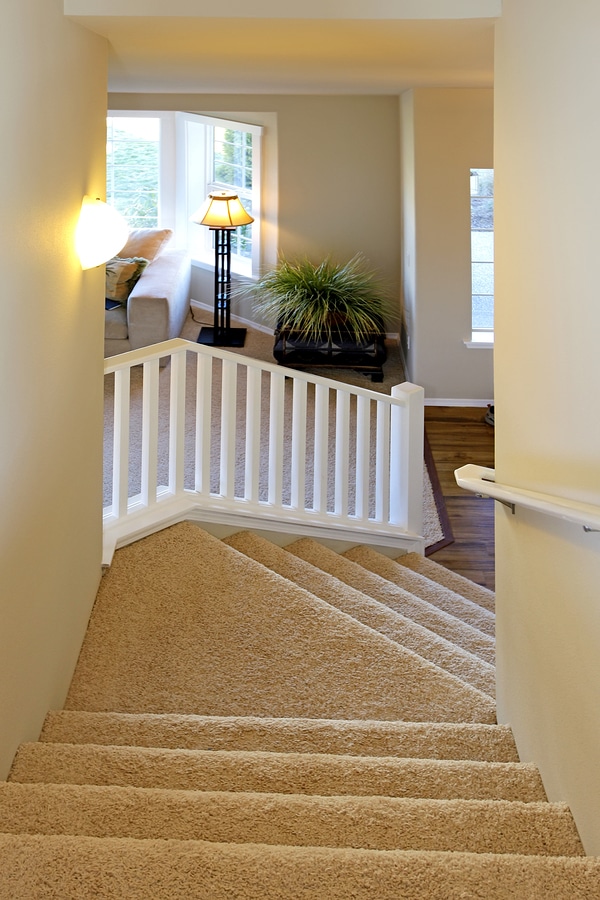As the years pass by, tasks that were once simple become harder to complete. Navigating stairs is a prime example of this gradual shift in mobility that many seniors experience. Senior home care providers can help seniors understand why stairs become more difficult and teach them strategies to overcome these challenges to help them maintain independence and prevent potentially dangerous falls.
Why Stairs Become More Challenging with Age
Several physiological changes contribute to decreased stair navigation abilities in seniors:
- Decreased Muscular Strength: After age 30, people begin losing 3-5% of muscle mass per decade. This muscle loss, known as sarcopenia, significantly impacts leg strength and stability. Quadriceps and calf muscles, crucial for climbing stairs, weaken over time, making each step harder than the next.
- Balance and Proprioception Deterioration: Age-related changes in the inner ear and nervous system impact balance and spatial awareness. As a result, the body’s ability to quickly adjust and maintain equilibrium becomes compromised, making stair climbing more hazardous than before.
- Vision Changes: Reduced depth perception, decreased contrast sensitivity, and slower visual processing make distinguishing individual steps more challenging. Additionally, shadows and lighting can create navigational difficulties as well.
- Joint Stiffness and Arthritis: Reduced joint flexibility, particularly in knees and hips, makes lifting legs and maintaining smooth motion more difficult. In addition, conditions like osteoarthritis can cause pain and increase mobility issues.
- Cognitive Processing Slowdown: Slower reaction times and reduced cognitive processing can make quick decision-making on stairs more challenging. While this may not seem like a significant issue, it can lead to seniors feeling less confident, which in turn increases their risk of falls.
Practical Tips to Make Stairs Safer and Easier
Senior home care can offer valuable recommendations for seniors and their loved ones to ensure stairs in the home are safe, as well as encourage seniors to use assistive devices if needed. Some tips include the following:
Home Modifications
- Install sturdy handrails on both sides of the staircase
- Ensure handrails extend beyond the first and last steps
- Add non-slip treads or strips to prevent slipping
- Improve lighting with bright, even illumination
- Consider contrasting color strips on step edges to enhance visibility
Assistive Devices and Strategies
- Use a walking cane or walker for additional support
- Consider stair lifts for multi-level homes
- Wear shoes with non-slip soles and good ankle support
- Take stairs slowly, using handrails consistently
- Use the “good leg/bad leg” technique: ascending with the stronger leg first, descending with the weaker leg leading
Physical Preparation
- Engage in regular strength training, focusing on leg muscles
- Practice balance exercises like tai chi or supervised physical therapy
- Maintain flexibility through gentle stretching
- Consider working with a physical therapist to develop personalized mobility strategies
When to Seek Help from Senior Home Care
While the above senior home care tips and recommendations can be helpful, it’s also important to know when stairs are too much of a risk and an alternative home layout needs to be considered. Some signs include the following:
- Frequent hesitation before climbing stairs
- Holding onto walls or furniture for support
- Experiencing breathlessness or significant fatigue
- Expressing a feeling of being unsteady
- Increase “near-fall” moments
Navigating stairs can be difficult for many seniors, but it doesn’t mean they need to lose their independence. With the right approach and support from senior home care, seniors can maintain mobility, confidence, and safety.
If you or an aging loved one is considering Senior Home Care in Clayton, MO, please contact the caring staff at Pear Tree Home Care today! (314) 942-9411
Pear Tree Home Care Provides Senior Home Care Services in St. Louis, Ladue, Chesterfield, Town and Country, Clayton, Des Peres, St. Charles, Wildwood, Brentwood, Maryland Heights, Lake St. Louis, O’Fallon, Kirkwood, Webster Groves, Arnold, Oakville, Mehlville, Creve Coeur, St. Louis City, St. Louis County, St. Charles County, Franklin County, Warren County, Jefferson County, and surrounding areas.
Sources:
- https://californiamobility.com/empowering-your-elderly-loved-one-tips-for-navigating-stairs/#:~:text=Have%20them%20hold%20the%20handrail,With%20a%20Wheelchair
- https://arrowlift.com/blog/helping-elderly-with-stairs/#:~:text=Enhancing%20Stair%20Safety%20with%20a,up%20and%20down%20the%20stairs.
- https://www.aarp.org/home-family/your-home/info-2022/ways-to-make-stairs-safer-at-home.html#:~:text=1.,are%20more%20likely%20to%20slip.
- https://my.clevelandclinic.org/health/diseases/23167-sarcopenia
At Pear Tree we’re innovators. Our goal, to create a family of caregivers looking to provide a one of a kind experience to our clientele.
In 2016, our founders noticed a key problem in home care industry that everyone seemed to be ignoring.
It’s too systematic. Home care isn’t one size fits all. Just like people aren’t one size fits all.
That’s where Pear Tree comes in.
We yearn for you to have the best possible care for your loved ones and the peace of mind that comes with knowing they aren’t only in good hands. They’re in great hands. Because, in the end, that’s what we’d want for our family.
It’s proven. When the home care experience is immersive and personalized, you’re going to produce better success rates with healthier family members.
Please, join us in our journey of revolutionizing the home care industry and creating lasting relationships along the way.
This is not the first Home Care agency for Pat, she was the Director of nursing for Kimberly Nurses in 1980 and after the tragic passing of the companies president she opened and co-founded American Nursing Resources Home Health Agency. Pat opened and passed Medicare certification for ANRHHA Clayton and Washington, MO offices.
For Zachary, the name “Pear Tree” is a tribute to his beloved late friend; Wade Abbadessa. Wade worked at his family’s famous restaurant “The Pear Tree” in Macon, until his tragic death in September 2014. Wade lost his battle with a rare form of bone cancer at the young age of 26. His legacy will live on through our company.
- How Home Care Supports Seniors’ Emotional Well-Being - May 23, 2025
- Alzheimer’s Care: Helping Seniors Maintain Their Daily Routine - May 7, 2025
- Helping Seniors Navigate Stairs - April 28, 2025





